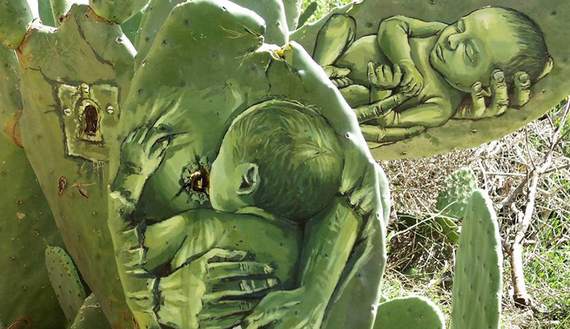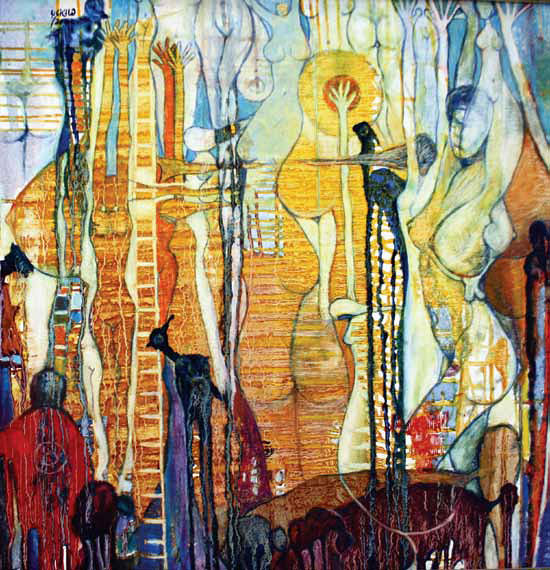Posted on:March 23, 2016
By
Ahmad Yaseen makes stunning drawings on cactus pads. His colleagues from the art faculty at An-Najah University in the Palestinian city of Nablus relate that people are impressed not only by his great skills as a painter but also by his original way of expressing Palestinian suffering: using a raw material that no one had ever before contemplated.

A picture shows Ahmad Yaseen’s favorite piece featuring two newborns and a lock, a recurring theme in his work. (photo by Ahmad Yaseen)
“I do not paint martyrs, nor do I paint scenes occurring in the current conflict between Israelis and Palestinians. I draw elements that provide also a glimmer of hope and not just despair,” Yaseen said in an interview with Al-Monitor. “Today, fear reigns supreme on the ground among my people, the Palestinians, but also among Israelis. Yet an artist should have a bird’s-eye view, and that’s what I do.”
A resident of Asira ash-Shamaliya, a village in the Samarian mountains near Nablus, Yaseen decided about a year ago that the cacti growing in and around his village would become his canvases. He realized that he could use them to accurately depict what the Palestinians are going through and how they live.
His favorite set of drawings is of two newborns. One is resting in his mother’s arms while the other is breastfeeding. From above, the arms of the mother of the second baby look like a keyless lock. Generally speaking, keys are a recurring motif in Yaseen’s drawings. “This is the key of return,” he explained, adding that it also represents hope.
“I have mumbled the words ‘sumud’ [perseverance] and ‘sabr’ [patience], and sabr sounds like ‘sabra’ [cactus],” he said. “Sabra is a plant symbolizing the land of Palestine, expressing the rugged nature of the people. It grows everywhere, under all weather conditions. Tenacious and strong, it is hard to stamp out. What better way than to use this plant through which to relate the Palestinian narrative?”
Ironically, the cactus is also a topic of conflict for Israelis and Palestinians. Israeli-born Jews call themselves “sabra,” appropriating the plant’s properties: coarse, rugged, tenacious on the outside but soft and sweet on the inside.
“Palestinians do not know what it is to be coddled and neither does the sabra,” Yaseen said. “This is the reason why its strong pads are able to handle the acrylic paints.”
The village residents find one of his paintings particularly moving, he said. It is a drawing of an old woman, her eyes tightly closed, clutching the symbolic key of return. The cactus pads embracing the old woman’s face look like a keffiyeh. A furrowed forehead symbolizes her hardships, but her hand firmly clutches the key.
Yaseen took photos of his artwork, inserting another element he might not have originally intended: Visible in the background, atop a high mountain, are the antennas of Elon Moreh — the cornerstone of Israel’s settlement enterprise in the territories.
In yet another impressive drawing, painted on a particularly wide and thick cactus pad, Yaseen combines two techniques. In a small indentation he set a stone, around which he drew a rugged hand. Intentionally or not, a fascinating symbol snuck into this painting as well. The thorns were removed from the wide pad on which the hand was painted, and in their place, the pits are reminiscent of shrapnel scars.
Although the first intifada took place before Yaseen was born and the Palestinian resistance had since undergone various changes, in his opinion the stone is the most appropriate representation of its character. It appears as if the stone is the most violent tool he is willing to depict. Other weapons, such as knives — the weapon of choice in the current intifada — are not featured in his paintings.
Yaseen struggles to transport his art. “One time I uprooted a cactus and took it with me to the faculty, but then the plant’s green color turned brown,” he said. The artist decided to plant the cactus in the middle of a sandbox and give it the desert conditions it loves. Lo and behold, the adaptive cactus survived, as did the painting.
“I would like to have an exhibition of my paintings,” he said, but added, “Maybe it’s better to hold one in the ground, at a place that has character, not just inside some gallery. But I need to give it some more thought.”
Yaseen relates that each painting takes hours and sometimes even days to complete. “The problem is that you can’t make any mistakes with a cactus,” he said. “I paint on a live canvas. In fact, I etch on the cactus pads. And if you make a mistake, it cannot be undone.”
To secure raw materials, Yaseen planted more cacti outside his home. All are destined, according to his plan, to one day become spectacular pieces of art.
Yaseen also paints on regular canvases. He likes to depict the ordinary lives of Palestinians, his village and Nablus, the capital of Samaria. He often incorporates his face using a technique that combines drawing and photography. One of his works features portraits of the French masters Paul Gauguin and Auguste Renoir, between which Yaseen is standing, sporting a broad smile and holding a marker.
He doesn’t dare dream of displaying his works in Israel. Yet he does hope that Israelis will see photos of his artwork and maybe identify with the object of his artistry: Palestinian suffering.
Source:



